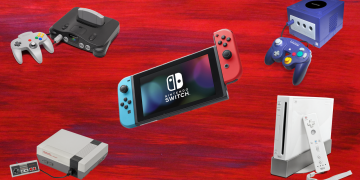When it comes to video games, no name resonates quite like Nintendo. From its inception, Nintendo has been a true trailblazer, always pushing boundaries and crafting legendary titles that continue to charm players decades later. With the much-anticipated launch of the Switch 2 on the horizon, it’s a perfect time to journey through Nintendo’s storied past in the console market and see how they’ve shaped the gaming landscape.
To do just that, we’ve compiled a comprehensive list of every Nintendo console ever released. Take a walk down memory lane and explore Nintendo’s evolution and its relentless drive to innovate!
If you’re looking for discounts on a new Nintendo Switch or the latest games, don’t miss out on the best Nintendo deals available today.
Throughout its history, Nintendo has launched 32 consoles, with the upcoming Switch 2 marking the 33rd. Our list covers both the original models and their various revisions like XL and Mini versions.
—
Starting with the Color TV-Game launched on June 1, 1977, this line marked Nintendo’s first dive into gaming hardware, albeit through a partnership with Mitsubishi Electronics due to Nintendo’s inexperience at the time. The series was a triumph, cementing Nintendo’s place in gaming hardware development. Almost half a century later, the impact of Color TV-Game persists, with Nintendo more dedicated than ever to gaming innovation.
The Game & Watch, released on April 28, 1980, marked Nintendo’s debut in the handheld market. Featuring a range of games, this series sold a staggering 40 million units worldwide. The Game & Watch introduced design innovations like the D-Pad, which were later integral to gaming. Nintendo paid homage to this line with limited edition releases for Mario and Zelda anniversaries in 2020 and 2021.
The Nintendo Entertainment System (NES), which debuted in North America on October 18, 1985, was known as the Family Computer (Famicom) in Japan. This revolutionary console used cartridges, allowing gamers to explore a multitude of titles. Iconic franchises such as Super Mario, The Legend of Zelda, and Metroid originated here, cementing the NES as a foundational piece of gaming history.
Next came the Game Boy on July 31, 1989, truly Nintendo’s first portable gaming system. It advanced from the Game & Watch by offering cartridge-based games like Tetris, which became inseparable from the Game Boy experience for many.
The Super Nintendo Entertainment System (SNES) arrived on August 23, 1991, bringing 16-bit graphics and ushering in major evolutions for flagship series through games like Super Mario World and Donkey Kong Country. Despite a late release during this console era, the SNES captivated gamers with its outstanding library and timeless appeal.
The Virtual Boy on August 14, 1995, remains one of Nintendo’s more eccentric endeavors. As the inaugural console showcasing 3D visuals, its market presence was brief, only lasting a year with under 800,000 units sold and a mere 22 games available.
The Game Boy Pocket, a sleeker version of the original Game Boy, launched on September 3, 1996. It boasted a refined black-and-white display and improved response times, although the compact design led to a shorter battery lifespan.
On September 29, 1996, the Nintendo 64 debuted, introducing 3D graphics on a Nintendo home console for the first time. This transformative console set the stage with groundbreaking titles like Super Mario 64 and The Legend of Zelda: Ocarina of Time, and an innovative controller with an analog stick.
Exclusively in Japan, the Game Boy Light became available on April 14, 1998. It maintained the Game Boy Pocket design but added a backlight, extending battery life significantly.
Later, the Game Boy Color finally brought vibrant visuals to Nintendo’s portable devices on November 18, 1998. With backward compatibility and the addition of completely new games, this device delivered a palpable upgrade to the previous handheld experience.
Following suit, the Game Boy Advance emerged on June 11, 2001, marking a substantial technological leap for Nintendo by adopting a horizontal design and providing 16-bit graphics, vastly enhancing the portable gaming ecosystem with thousands of available titles.
The Pokémon Mini followed on November 16, 2001, focusing solely on pocket-sized Pokémon games. Offering only ten titles, this diminutive device had limited releases but featured interesting functionalities like an infrared port and built-in rumble.
November 18, 2001, saw the introduction of the Nintendo GameCube, which built upon the successes of previous consoles, embracing discs over cartridges and offering enhancements like rumble and improved controller design. Its legacy endures through enduring titles and franchises it helped amplify.
Released out of collaboration with Panasonic, the Panasonic Q emerged on December 14, 2001. It combined GameCube gaming with DVD playback, albeit with limited commercial success.
Then came the Game Boy Advance SP on March 23, 2003, known for its clamshell design, rechargeable battery, and later models’ backlit screen, despite omitting a headphone jack.
The Nintendo DS, launched on November 21, 2004, switched things up with Wi-Fi capability and a unique clamshell design housing two screens, one being a touchscreen—a defining feature for the DS family.
On September 19, 2005, the Game Boy Micro surprised many with its compact size and distinctive design. Its short lifespan saw limited unit sales, yet it remains memorable for its diminutive form factor.
Just over a year later, on June 11, 2006, the Nintendo DS Lite arrived as a refined version of its predecessor—lighter, brighter, and equipped with improved battery life.
The Wii hit shelves on November 19, 2006, reviving Nintendo’s home console success with motion controls and engaging gameplay that attracted a broad audience. The Wii’s backward compatibility and Virtual Console offerings expanded its entertainment possibilities.
The Nintendo DSi, released on November 1, 2008, added cameras and an SD card slot, though it lost the Game Boy Advance slot, underscoring the evolving focus on downloadable content.
Larger screens and enhanced speakers distinguished the Nintendo DSi XL, released on November 21, 2009, offering improved clarity and sound.
On March 27, 2011, 3D visuals came to life with the Nintendo 3DS, elevating gaming through stereoscopic technology and delivering standout titles without the need for special glasses.
The Nintendo 3DS XL followed on August 19, 2012, providing larger screens for a more immersive experience, particularly with the bottom touch screen.
The Wii U, out on November 18, 2012, introduced a dual-screen experience with its GamePad while debuting HD graphics. Though the concept dangled potential, it struggled with market appeal.
The more compact Wii Mini was released on December 7, 2012, stripping away certain features to provide a cost-effective alternative late in the console’s lifecycle.
Nintendo’s affordable 2DS arrived on October 12, 2013, absent of 3D functionality while maintaining the ability to play all DS and 3DS titles.
The New Nintendo 3DS, on October 11, 2014, added features like the C-Stick and NFC support, aiming to enhance interactivity and connectivity.
The New Nintendo 3DS XL released earlier on February 13, 2015, sans customizable faceplates but with even larger screens for enriched gameplay.
Enter the revolutionary Nintendo Switch on March 3, 2017, bridging the gap between portable and home console gaming. Boasting a stellar library, the Switch solidified Nintendo’s position at the forefront of gaming.
Meanwhile, the New Nintendo 2DS XL offered an enhanced 2DS experience on July 28, 2017, bringing back the beloved clamshell design and adding amiibo support.
In a portable twist, the Nintendo Switch Lite debuted on September 20, 2019, focusing solely on handheld gaming through a streamlined design and fixed controllers.
The premium Nintendo Switch OLED Model landed on October 8, 2021, offering a larger, vibrant OLED display and improved features such as enhanced speakers and a better kickstand.
Anticipation builds as the Nintendo Switch 2, previewed during the April 2025 Nintendo Direct, gears for a June 5 release, promising an ambitious redesign with expanded storage and innovative controls. Priced at $449.99, or bundled with the new Mario Kart World game at $499.99, this release will revolutionize the Nintendo gaming experience.
Looking forward, it remains to be seen whether the Switch 2 will evolve further with variations like those that preceded it. But for now, let’s enjoy what this upcoming console has to offer.
—
Eight years after revolutionizing gaming with the original Nintendo Switch, excitement mounts for the launch of the Switch 2. While it’s tempting to speculate about the future, let’s focus on the arrival of this next-gen console. Whether or not Nintendo will opt for different variations of the new system remains to be seen, but the anticipation is certainly building.
—
Noah Hunter is a freelance writer and reviewer with a knack for exploring the latest in games and technology. As the co-founder of Final Weapon, an outlet that sidesteps the fluff to deliver the essence of Japanese gaming, he’s contributed his insightful perspectives to various publications.











![[FREE Game] Giveaway for Lost Records: Bloom and Rage on PlayStation 5 (North America) [FREE Game] Giveaway for Lost Records: Bloom and Rage on PlayStation 5 (North America)](https://www.truegames.net/wp-content/uploads/2025/04/FREE-Game-Giveaway-for-Lost-Records-Bloom-and-Rage-on-360x180.jpg)





















![[Industry Insider] Launching a New Era in VR Gaming: ‘The ChicKing Dead’ Now in Early Access! [Industry Insider] Launching a New Era in VR Gaming: ‘The ChicKing Dead’ Now in Early Access!](https://www.truegames.net/wp-content/uploads/2025/04/Industry-Insider-Launching-a-New-Era-in-VR-Gaming-The-360x180.jpg)













